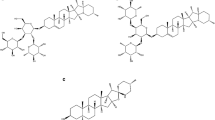Abstract
Purpose
Cyanide, its metabolite thiocyanate and azide in human biological fluids are commonly analyzed by gas chromatography–mass spectrometry (GC–MS) after derivatization with pentafluorobenzyl bromide using extractive alkylation. However, the reported methods have some drawbacks. We examined each step of these reported methods and attempted to establish a more reliable method to determine the levels of the above compounds in human whole blood. We also examined the applicability of the established method to NAGINATA–GC–MS screening.
Methods
The deproteinization method, internal standard (IS), the cause of column damage, and the effect of the addition of ascorbic acid were examined, and the best procedure was selected. The obtained data, including mass specta, retention times and calibration curves were registered to the database of NAGINATA software.
Results
The analysis of cyanide in whole blood was possible only when the blood was deproteinized with trichloroacetic acid. A high recovery of thiocyanate and azide was obtained without the deproteinization step. K13C15N (for cyanide) and tribromobenzene (for thiocyanate and azide) were selected as ISs. The column damage caused by the phase transfer catalyst was successfully eliminated by passing the catalyst containing solution through an ethyl benzoic sulfonic silica gel column. By these improvements, a more reliable determination method was established. All anions were rapidly identified using NAGINATA software, and the approximate concentration of each compound in whole blood was obtained at the same time.
Conclusions
Because NAGINATA–GC–MS screening can rapidly identify these poisons without using toxic compounds as reference standards, it should be useful in forensic and emergency medicine laboratories.




Similar content being viewed by others
References
Le Garff E, Delannoy Y, Mesli V, Allorge D, Hédouin V, Tournel G (2016) Cyanide suicide after deep web shopping: a case report. Am J Forensic Med Pathol 37:194–197
Musshoff F, Schmidt P, Daldrup T, Madea B (2002) Cyanide fatalities: case studies of four suicide and one homicide. Am J Forensic Med Pathol 23:315–320
Peddy SB, Rigby MR, Shaffner DH (2006) Acute cyanide poisoning. Pediatr Crit Care Med 7:79–82
Meatherall R, Oleschuk C (2015) Suicidal fatality from azide ingestion. J Forensic Sci 60:1666–1667
Schwarz ES, Wax PM, Kleinschmidt KC, Sharma K, Chung WM, Cantu G, Spargo E, Todd E (2014) Multiple poisoning with sodium azide at a local restaurant. J Emerg Med 46:491–494
Kikuchi M, Sato M, Ito T, Honda M (2001) Application of a new analytical method using gas chromatography and gas chromatography mass spectrometry for the azide ion to human blood and urine samples of actual case. J Chromatogr B 752:149–157
Kage S, Nagata T, Kudo K (1996) Determination of cyanide and thiocyante in blood by gas chromatography and gas chromatography–mass spectrometry. J Chromatogr B 675:27–32
Bhandari RK, Oda RP, Youso SL, Petrikovics I, Bebarta VS, Rockwood GA, Logue BA (2012) Simultaneous determination of cyanide and thiocyanate in plasma by chemical ionization gas chromatography mass-spectrometry (CI-GC–MS). Anal Bioanal Chem 404:2287–2294
Paul BD, Smith ML (2006) Cyanide and thiocyanate in human saliva by gas chromatography–mass spectrometry. J Anal Toxicol 30:511–515
Bhandari RK, Manandhar E, Oda RP, Rockwood GA, Logue BA (2014) Simultaneous high-performance liquid chromatography–tandem mass spectrometry (HPLC–MS–MS) analysis of cyanide and thiocyanate from swine plasma. Anal Bioanal Chem 406:727–734
Ohmori T, Ohsawa I, Komano A, Kishi S, Sato T, Seto Y (2014) High distribution of azide in blood investigated in vivo, and its stability in blood investigated in vitro. Forensic Toxicol 32:251–257
Kage S, Kudo K, Ikeda N (2000) Determination of azide in blood and urine by gas chromatography–mass spectrometry. J Anal Toxicol 24:429–432
Kudo K, Ishida T, Hikiji W, Hayashida M, Uekusa K, Usumoto Y, Tsuji A, Ikeda N (2009) Construction of calibration-locking databases for rapid and reliable drug screening by gas chromatography–mass spectrometry. Forensic Toxicol 27:21–31
Kudo K, Usumoto Y, Usui K, Hayashida M, Kurisaki E, Saka K, Tsuji A, Ikeda N (2014) Rapid and simultaneous extraction of acidic and basic drugs from human whole blood for reliable semi-quantitative NAGINATA drug screening by GC–MS. Forensic Toxicol 32:97–104
Seto Y (1995) Oxidative conversion of thiocyanate to cyanide by oxyhemoglobin during acid denaturation. Arch Biochem Biophys 321:245–254
Desharnais B, Huppé G, Lamarche M, Mireault P, Skinner CD (2012) Cyanide quantification in post-mortem biological matrices by headspace GC–MS. Forensic Sci Int 222:346–351
McAllister JL, Roby RJ, Levine B, Purser D (2011) The effect of sodium fluoride on the stability of cyanide in postmortem blood samples from fire victims. Forensic Sci Int 209:29–33
McAllister JL, Roby RJ, Levine B, Purser D (2008) Stability of cyanide in cadavers and in postmortem stored tissue specimens: a review. J Anal Toxicol 32:612–620
Baselt RC (2017) Disposition of toxic drugs and chemicals in man, 11th edn. Biomedical Publications, Seal Beach
Acknowledgements
The authors thank Dr. Shigetoshi Kage for his helpful comments on this work. This work was supported by a Grant-in-Aid for Scientific Research (nos. 26460881 and 17K19819) from the Ministry of Education, Science, Technology, Sports, and Culture of Japan. The authors would like to thank Enago (http://www.enago.jp) for the English language review.
Author information
Authors and Affiliations
Corresponding author
Ethics declarations
Conflict of interest
There are no financial or other relationships that could lead to a conflict of interest.
Ethical approval
This article does not contain any studies with human participants or animals performed by any of the authors. The analysis of toxic substance(s) in whole blood samples collected from a cadaver was requested by judicial authorities with official documentation.
Rights and permissions
About this article
Cite this article
Kudo, K., Usumoto, Y., Sameshima, N. et al. Reliable determination of cyanide, thiocyanate and azide in human whole blood by GC–MS, and its application in NAGINATA–GC–MS screening. Forensic Toxicol 36, 160–169 (2018). https://doi.org/10.1007/s11419-017-0397-2
Received:
Accepted:
Published:
Issue Date:
DOI: https://doi.org/10.1007/s11419-017-0397-2




